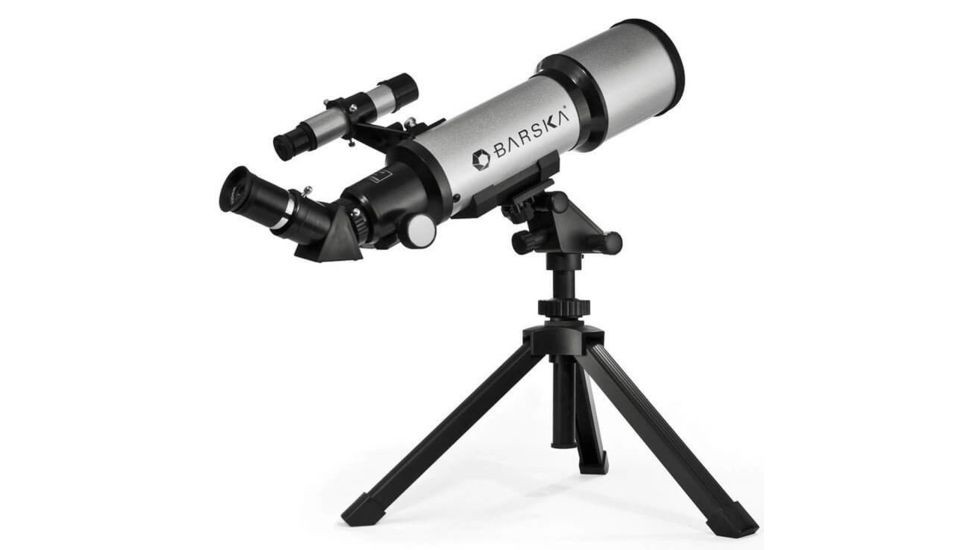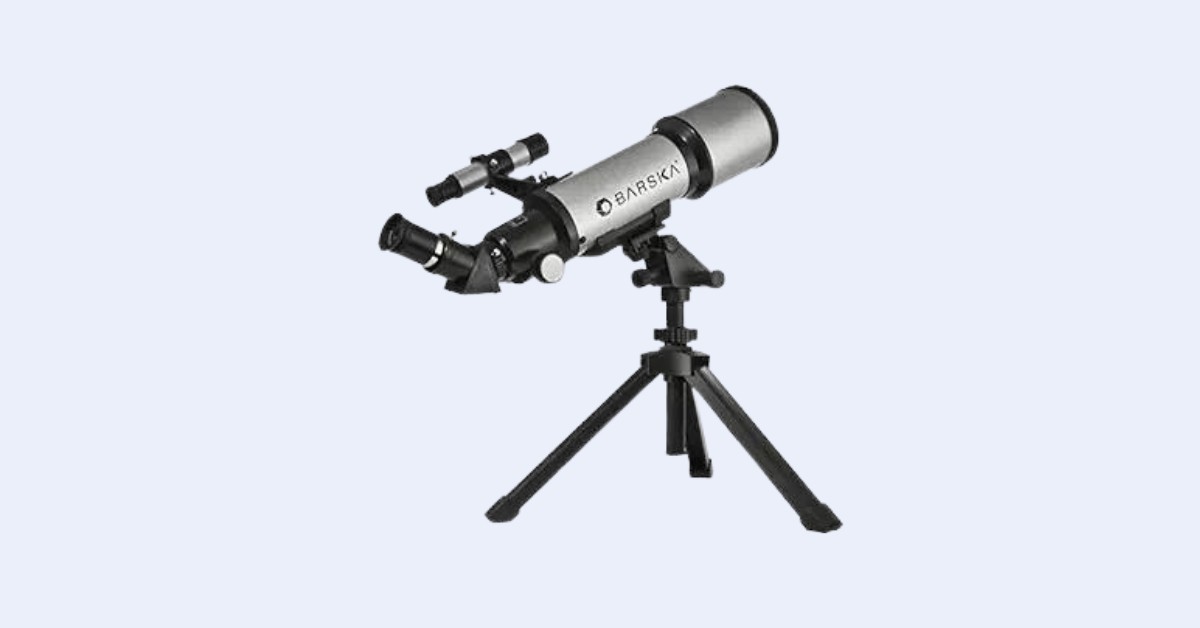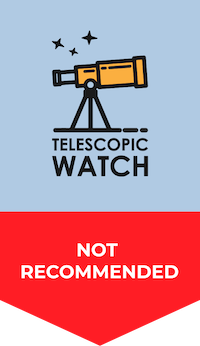Overview Of The Starwatcher 400×70
Right away, the first thing that should raise red flags about the Starwatcher is the fact that it advertises its magnification as 300x.
Not only is this completely impossible with a 70mm telescope, let alone a short achromatic refractor with optics that are dubious in quality, but you should avoid any telescope marketing itself on the basis of “power”. More magnification doesn’t let you see more, and too much will result in a blurry, unfocusable, shaky image.
A good 70mm refractor would be capable of about 130x magnification at most, and the Starwatcher 400×70 is far from being a good telescope.

Every year, many people who have never used a real telescope before (or do not remember the experience) buy the Starwatcher 400×70 believing it is a decent telescope based on its positive reviews, get a half-decent view of the Moon and its craters or see a random star field, and conclude that it is a satisfactory telescope at least for the price, giving it a 4 or 5-star review and then putting it away and forgetting about it, with the occasional person giving it a downright negative review when they realize how terrible it is.
This cycle spawns more unwitting consumers doing the same thing, and as of the time of publishing this article, the Starwatcher 400×70’s 300 reviews on Amazon average it out at 3.5 out of 5 stars The same pattern happens with many “department-store” or simply mediocre telescopes sold on the Internet, leading for more and more junk telescopes to be churned out and allowing the cycle to continue.
That being said, let’s get on to actually going over this joke of a telescope.
The Optical Tube
The Starwatcher 400×70 is (as the somewhat backward naming scheme describes) a 70mm f/5.71 doublet achromatic refracting telescope with a focal length of 400mm. Being an achromatic refractor with such a fast focal ratio, it is pretty much a low-power, wide-field telescope. I would probably not want to take the magnification above 80x if it had good optics and a steady mount, which of course it has neither.
Expecting almost anything at all of the Starwatcher 400×70 is expecting too much of it. It doesn’t have good optics. The objective lens is glass, but not good glass, not well-figured glass, and not well-coated glass. The chromatic aberration this scope produces is unusually high, and it’s not helped by its cheap diagonal and eyepieces (which we’ll get to later). The lens cell also seems to pinch down on the objective itself, causing stars to have funny-looking shapes even when in “focus” and the image to deteriorate even further.
The Starwatcher’s tube is plastic, as is pretty much everything else. I think the only metal components on the entire telescope might be the screws attaching the focuser and objective to the tube, and the thumbscrews for the focuser, finder, and diagonal.
Accessories
The Starwatcher 400×70’s finderscope is a 5×24 unit. The tube and bracket are plastic, the objective lens is a single plastic element, and it’s stopped down to contain the terrifying aberrations a plastic, fast singlet lens will, of course, produce combined with the eyepiece, which is so bad that Galileo probably had something better. The inside of the tube isn’t even painted black. Sighting down the tube is more effective than using this abomination.
The Starwatcher 400×70 comes with two eyepieces: A 20mm Kellner providing 20x and a 4mm Ramsden providing 100x, as well as a 3x Barlow to provide the advertised 300x when used with the 4mm Ramsden.
The 20mm Kellner produces a ridiculous amount of added chromatic aberration and I find the field of view so narrow that I think it might be a falsely-labeled Huygens. The lenses appear to be plastic, too. However, it can’t compare to the horrors of the 4mm Ramsden. Not only does it provide more magnification than the scope can handle in the first place, but the thing is entirely plastic, has a recessed eye lens and no eye relief to speak of, and is like looking through a soda straw. I didn’t think that you could make a worse 4mm Ramsden than the one supplied with Celestron’s PowerSeeker telescopes. I was wrong because this thing somehow is worse.
The 3x Barlow is of course entirely unusable, being entirely plastic and providing too much magnification even with the 20mm eyepiece, in addition to throwing up all kinds of aberrations due to its single plastic lens.
The Starwatcher 400×70’s diagonal is a 45-degree erecting prism unit. Not only is this not the right design for astronomical use, but it absorbs a lot of the scope’s already meager light-collecting ability, adds chromatic aberration, and shows severe double/ghost images.
The scope’s case is a soft fabric unit and actually isn’t bad. However, I have read reports of it arriving damaged, moldy, or rotted, so buyer beware.
How Terrible Is The Mount?
If everything I’ve already said hasn’t already convinced you not to buy the Starwatcher 400×70, I hope that the mount does. It is mildly more useful than cradling the tube in your arms or looking straight through it, sans diagonal, like a pirate.
The Starwatcher 400×70’s mount is based on the uber-cheap tabletop tripods meant to hold small digital cameras. The scope’s center of mass is offset from the fulcrum of the mount, meaning the mount’s altitude axis must be tightened all the time. The mount’s bearings are plastic on plastic, and trying to tighten either axis is just pressing the squeaky, cheap plastic parts against each other, meaning that you cannot get fluid motion. The scope’s tabletop “sturdy adjustable tripod” is a joke, and I really don’t have many words beyond that to describe it.
Looking For Better Alternatives?
- Zhumell Z100: Larger aperture means more things to see, tabletop design is steadier and more portable, comes with superior optics and accessories.



